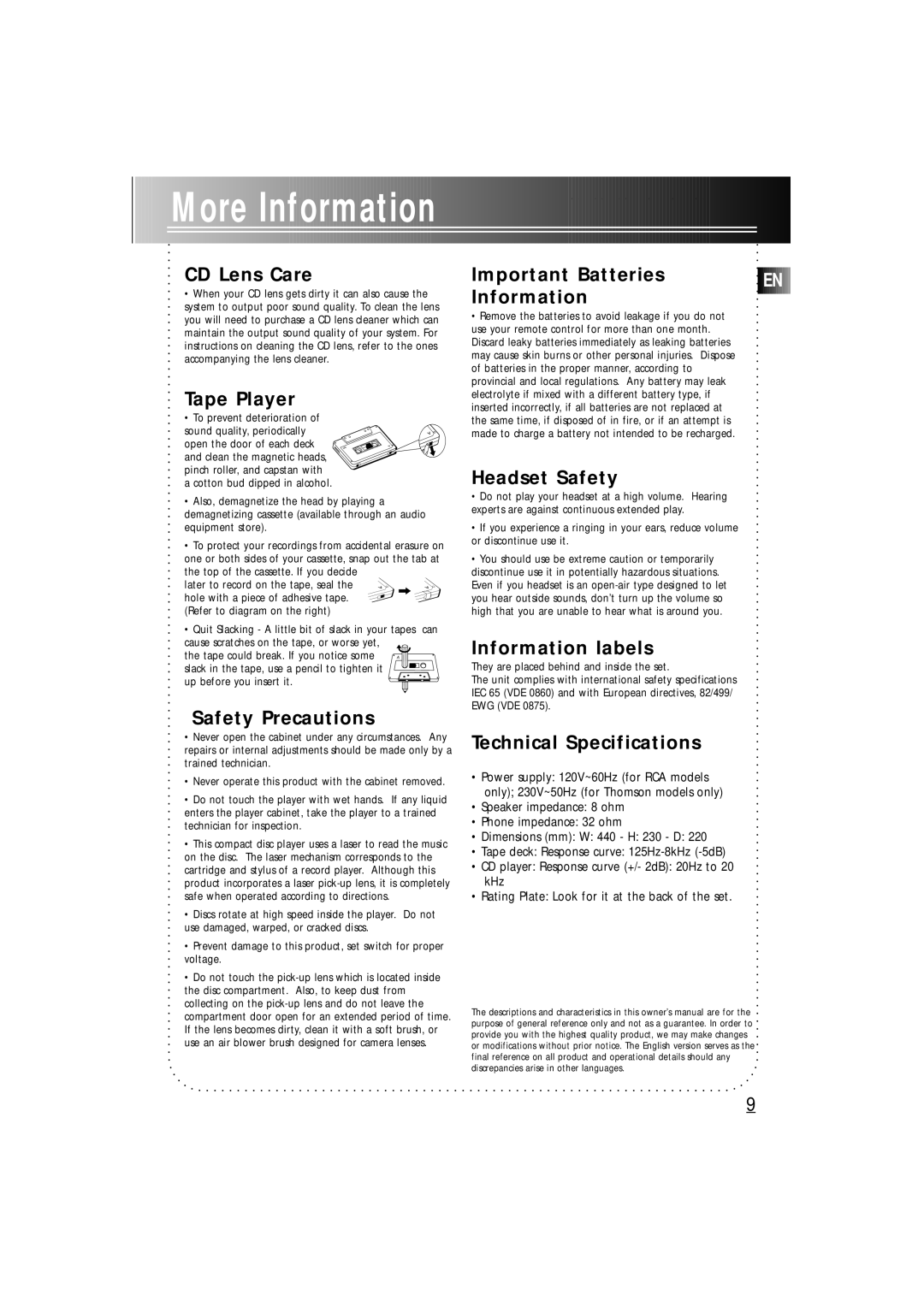
CD Lens Care
•When your CD lens gets dirty it can also cause the system to output poor sound quality. To clean the lens you will need to purchase a CD lens cleaner which can maintain the output sound quality of your system. For instructions on cleaning the CD lens, refer to the ones accompanying the lens cleaner.
Important Batteries
Information
• Remove the batteries to avoid leakage if you do not |
use your remote control for more than one month. |
Discard leaky batteries immediately as leaking batteries |
may cause skin burns or other personal injuries. Dispose |
of batteries in the proper manner, according to |
provincial and local regulations. Any battery may leak |
Tape Player
•To prevent deterioration of sound quality, periodically open the door of each deck and clean the magnetic heads, pinch roller, and capstan with a cotton bud dipped in alcohol.
60
A
A
electrolyte if mixed with a different battery type, if |
inserted incorrectly, if all batteries are not replaced at |
the same time, if disposed of in fire, or if an attempt is |
made to charge a battery not intended to be recharged. |
Headset Safety
•Also, demagnetize the head by playing a demagnetizing cassette (available through an audio equipment store).
•To protect your recordings from accidental erasure on one or both sides of your cassette, snap out the tab at the top of the cassette. If you decide
later to record on the tape, seal the | A | A |
hole with a piece of adhesive tape. |
|
|
(Refer to diagram on the right) |
|
|
•Quit Slacking - A little bit of slack in your tapes can cause scratches on the tape, or worse yet,
the tape could break. If you notice some | A | |||
slack in the tape, use a pencil to tighten it |
|
|
|
|
|
|
|
| |
up before you insert it. |
|
|
|
|
|
|
|
| |
Safety Precautions
•Never open the cabinet under any circumstances. Any repairs or internal adjustments should be made only by a trained technician.
•Never operate this product with the cabinet removed.
•Do not touch the player with wet hands. If any liquid enters the player cabinet, take the player to a trained technician for inspection.
•This compact disc player uses a laser to read the music on the disc. The laser mechanism corresponds to the cartridge and stylus of a record player. Although this product incorporates a laser
•Discs rotate at high speed inside the player. Do not use damaged, warped, or cracked discs.
•Prevent damage to this product, set switch for proper voltage.
•Do not touch the
use an air blower brush designed for camera lenses.
•Do not play your headset at a high volume. Hearing experts are against continuous extended play.
•If you experience a ringing in your ears, reduce volume or discontinue use it.
•You should use be extreme caution or temporarily discontinue use it in potentially hazardous situations. Even if you headset is an
Information Iabels
They are placed behind and inside the set.
The unit complies with international safety specifications IEC 65 (VDE 0860) and with European directives, 82/499/ EWG (VDE 0875).
Technical Specifications
•Power supply: 120V~60Hz (for RCA models only); 230V~50Hz (for Thomson models only)
•Speaker impedance: 8 ohm
•Phone impedance: 32 ohm
•Dimensions (mm): W: 440 - H: 230 - D: 220
•Tape deck: Response curve:
•CD player: Response curve (+/- 2dB): 20Hz to 20 kHz
•Rating Plate: Look for it at the back of the set.
The descriptions and characteristics in this owner’s manual are for the purpose of general reference only and not as a guarantee. In order to provide you with the highest quality product, we may make changes or modifications without prior notice. The English version serves as the final reference on all product and operational details should any discrepancies arise in other languages.
9
